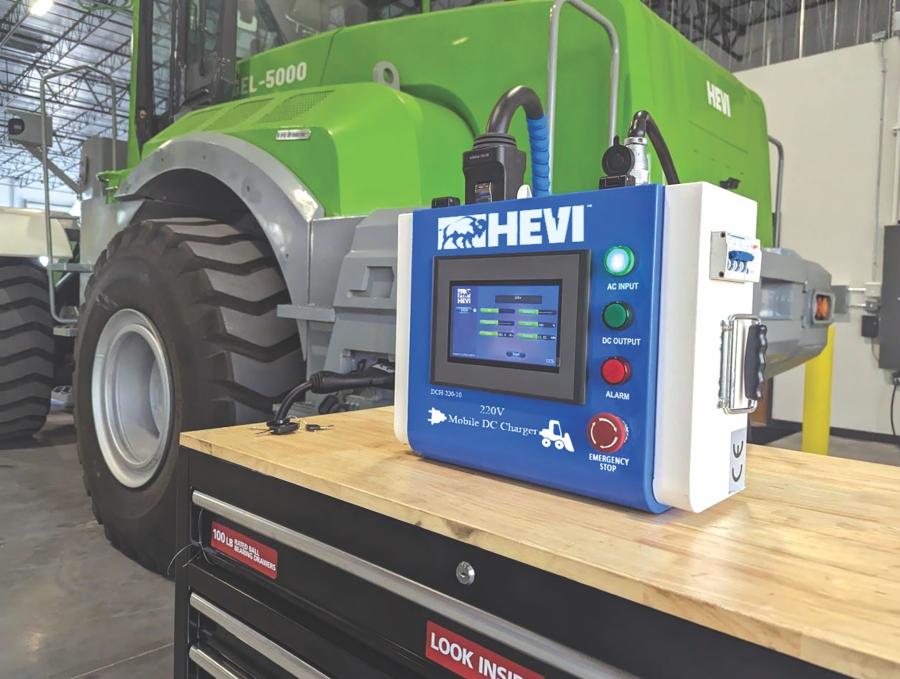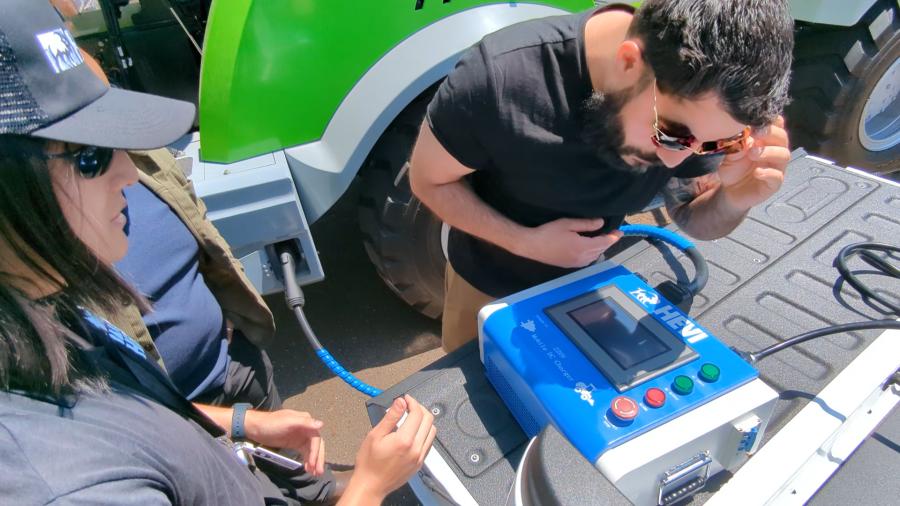HEVI’s DCH-220-10 non-stationary DC chargers is transportable — 16 in. by 13 in. by 7 in.— and can connect to a piece of equipment up to 35 ft. from a 220V plug-in.
(HEVI photo)
EV is the heart of N.J.-based HEVI equipment.
The heavy equipment manufacturer crafted its name around all-electric vehicles because its machines are built around battery power. That's the brand and the company's "HEVI-duty" commitment since 2019 — to support a sustainable future by deploying clean-technology solutions to the industrial sector.
HEVI's products include two wheel loaders and one wheeled excavator, with plans for a tracked excavator model in 2024. Its current flagship model is the GEL-5000, a 20-ton wheel loader with a 3.9-cu.-yd. bucket, and has already been on demo sites during the company's 2023 road show.
As a manufacturer, HEVI believes it's in a unique position to deliver electric heavy equipment on a short timeline. It's able to deliver its equipment with only a six- to eight-month lead time, which "puts us in a competitive position," according to HEVI.
While HEVI does not manufacture the batteries used in its machines, "they are custom-built for us," said Stanley Wang, the company's vice president of business development. "The assembly is specific to our electric heavy equipment."
CATL (Contemporary Amperex Technology Co.), manufactures the batteries and is a supplier for many of the world's largest automakers, including BMW, General Motors, Tesla and Volkswagen.
They are lithium ferrophosphate units of various sizes. HEVI's smaller loader, the GEL-1800, and its GEX-8000 wheeled excavator are powered by an identical battery, a 141-kWh unit. On the other hand, the manufacturer's largest wheel loader, the GEL-5000 requires a 282-kWh battery. That need is simply met: Two of the smaller batteries are stacked. The resulting power unit weighs more than a ton.
That they are lithium ferrophosphate (LFP) units is significant. LFP is a subtype of lithium-ion batteries (like Lithium Manganese Oxide or Lithium Cobalt Oxide) that provides unique benefits owing to its chemical composition.
"We selected ferrophosphate [lithium iron phosphate] because they have higher safety and lifespan than other Lithium-ion types," said Wang. "Their high specific power is also required to deliver the proper energy to the hydraulic systems.
"At HEVI safety is paramount," Wang added. "We employ an air and liquid battery coolant system to control battery temperature and encase the battery in a steel enclosure to protect it from damage resulting from an impact. Battery fires in EVs primarily occur from damage to the battery pack. For instance, if the battery is punctured, the damaged area can cause a short in one of the cells causing the chain reaction called ‘Thermal Runaway.' If you can prevent punctures, you can prevent one of the main risks posed by batteries."
Considering that the battery constitutes approximately one-third the cost of a machine, protecting it becomes a practical necessity.
While Wang doesn't see any advance in battery technology for heavy equipment any time soon, sodium batteries are under development for lighter vehicles. When those do become generally available for equipment, Wang said they will appeal to U.S. manufacturers like HEVI because sodium can be mined in and near the United States whereas lithium is a natural resource found in distant places like China and Africa.
Some reluctance of contractors to embrace all-electric heavy equipment revolves around questions of productivity. That is, while work sites will be cleaner and equipment noise abated by using all-electric machines, will the equipment keep running long enough to get a job done before their batteries die?
Absolutely, said Wang.
"With our machines, you are looking at nine hours of active use between charges," he said, adding that the machines are a perfect fit for material-handling yards, factories and warehouses, and other urban workplaces where 40-45-hour work weeks are the rule.
While charging such large batteries is not an easy task and with the EV charging infrastructure in the United States still in its infancy, HEVI wanted to ensure that its customers wouldn't have to worry about finding power. To this end, they've developed a charging system that's unlike anything else in the industry — non-stationary direct-current (DC) chargers.
"They are unique," said Wang. "They're the only non-stationary DC chargers in the world."
EV cars such as are produced by Tesla have converters that change AC electrical input from external electrical sources into DC power for storage in the vehicle's DC battery. Current charging standards mean that AC power charges more slowly — but as noted previously, you likely won't find a DC charging solution that isn't fixed to a gas station or a parking lot.
"The only DC charging sources are in recharging stations — DC Fast Chargers," said Wang. These are the units that look similar to gas pumps but have been popping up in commercial parking lots and shopping malls. While useful for EVs, they're less so for heavy equipment.
So while it imagined its electric equipment as a new sustainable solution for industry, HEVI knew it couldn't leave its customers alone facing new problems, Wang said.
"You can't drive a loader somewhere to a charging station and that's why we offer these recharging systems."
Two years ago, HEVI began development of its non-stationary DC chargers. One is the DCH-220-10, rated for 10 kW of output from a standard 220V line. It is of transportable dimensions — 16 in. by 13 in. by 7 in.— and can connect to a piece of equipment up to 35 ft. from a 220V plug-in.
The other HEVI charger is the DCH-480-30, which is compatible with 480-volt outlets in industrial settings and is rated for 30 kW. It is somewhat larger in size, but still transportable. The smaller charger weighs 66 lbs., the larger one is 220 lbs., changing the game for onsite refueling. What sometimes necessitated truck-mounted diesel tanks, or large, on-site storage now only requires some simple equipment that can fit easily into a sedan. HEVI has even charged its GEL-1800 using a Ford F150 Lightning, a setup that allows you to turn that electric pickup truck into a mobile charging station for your heavy equipment.
And how quickly can the charging units restore a piece of equipment to full power? With HEVI's proprietary charger, the company expects an overnight charge is all it would take. Using the DC fast charging station can achieve a full recharge in 30 to 90 minutes. (HEVI recommends that you operate the batteries within the recognized 15 to 80 percent state of charge; doing so helps preserve optimal battery life.)
For the applications these machines are intended for, Wang notes that these charging times should fit well into daily work routines. When asked about whether charging times will get faster, Wang said, "The DC Fast Charging stations we see now were only developed and installed in the past couple years, and we constantly see them improving by bringing faster charging times. Our non-stationary DC chargers have only just arrived and will benefit from the rapid advancements in charging tech in pretty much the same way.
"In the meantime, our chargers can work anywhere there is a 220V or 480V connection for the DCH-220-10 and DCH-480-30, respectively," said Wang.
"We are constantly exploring solutions that will help our equipment operate seamlessly on an increasing variety of work sites."
The business development executive was asked if the company, which has dedicated itself to environmentally sustainable solutions, has considered similar options, such as hydrogen-powered equipment. "We are aware of it and may look at hydrogen in the future," he said. "At the moment, EV is still a very new but viable industry. Hydrogen is not even close to being a practical option, yet."
For HEVI, providing sustainable solutions right now is critical to its mission.
HEVI is quickly establishing itself as a leader toward a sustainable future. While there is still much work to do to eliminate industrial emissions, Wang is passionate about HEVI being a major player in that endeavor. With increasing regulatory pressure toward "green initiatives," he sees his entire team as stewards to help construction industry contractors meet these requirements and to do so competitively, efficiently and affordably.
Wang expressed pride in everything HEVI has accomplished since they began in 2019.
"With HEVI at the forefront of heavy equipment electrification, battery power in this industry is no longer a far-fetched concept," he said. "For the first time, businesses have an immediate, cost-effective and eco-friendly alternative to diesel."
Today's top stories


















